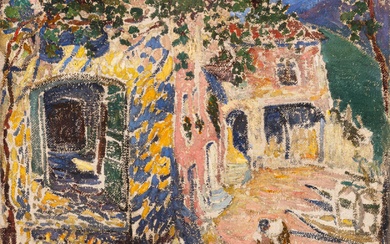Mela Muter (Maria Melania Mutermilch), Spanischer Tanz (Danse espagnole)
Mela Muter (Maria Melania Mutermilch)
Warsaw 1876 - 1967 Paris
Spanischer Tanz (Danse espagnole)
1913
Oil on canvas. 136 x 146 cm. Framed. Signed 'Muter' in black lower left. - Unobtrusive vertical felled seam in the left third of the painting and smaller rubbing in the lower part as well as minute damage to canvas in the centre. Mounted on newer stretcher. Provenance
Artist's estate; Galerie Bargera, Cologne (frame label) Exhibitions
Paris 1966 (Galerie Jean-Claude Bellier), Mela Muter, cat. 24, with colour illus. on the title; Cologne 1966 (Galerie Gmurzynska), Mela Muter: Bilder, Aquarelle und Zeichnungen, cat. no. 29, with full page colour illus.; Cologne 1967 (Galerie Gmurzynska), Mela Muter 1876-1967. Retrospektiv-Ausstellung, cat. no. 1, with colour illus. on the title
“A unique artist” is what the art critic Robert Kemp wrote of Mela Muter in 1913, the year this painting was created. “And what authority, what original mastery, what precise and enthralling ability! […] She leaves areas unpainted and they become significant, emphasised. The drawing is clear, strong-willed and solid without a reinforcing line. This resembles nothing that has previously existed. It is hallucinatory, extremely adept.” (Robert Kemp, cited in: exhib. cat. Cologne 1976, op. cit., n. pag.). As one of Mela Muter's most important and impressive works, the “Spanischer Tanz” adorned the cover of the catalogue for the 1967 retrospective organised by Galerie Gmurzynska. The painting confronts its viewers with a large-format figural scene featuring a seemingly folkloric theme, however, the artist has executed it in an entirely unconventional manner. The monumental figure of a seated guitar player dominates the image. A dog has nestled its head on his right knee while, to his left, a pair of children dance to the music of the guitar with expressive movements. The group fills the entire picture plane, and the sides of the painting directly seem to crowd them in. This constricted space renders the lack of relationship between the figures particularly striking. They seem absorbed in their own worlds, their gazes make contact neither with each other nor with their viewers. The bodies twist inwards while the raised shoulders, strained limbs and skewed axes of the figures invest them with a marionette-like quality and run counter to the vigour and passion that viewers associate with Spanish dances. The muted and chalky tonality, which is characteristic of Mela Muter's work, underscores the melancholy atmosphere. People from the common folk were among Muter's favourite subjects for her pictures. She travelled in Spain multiple times during the years preceding World War I and that is apparently where she found the inspiration for this village dance scene. We also encounter the models for the two child dancers in other works from this period.
View it on
Sale price
Estimate
Time, Location
Auction House
Mela Muter (Maria Melania Mutermilch)
Warsaw 1876 - 1967 Paris
Spanischer Tanz (Danse espagnole)
1913
Oil on canvas. 136 x 146 cm. Framed. Signed 'Muter' in black lower left. - Unobtrusive vertical felled seam in the left third of the painting and smaller rubbing in the lower part as well as minute damage to canvas in the centre. Mounted on newer stretcher. Provenance
Artist's estate; Galerie Bargera, Cologne (frame label) Exhibitions
Paris 1966 (Galerie Jean-Claude Bellier), Mela Muter, cat. 24, with colour illus. on the title; Cologne 1966 (Galerie Gmurzynska), Mela Muter: Bilder, Aquarelle und Zeichnungen, cat. no. 29, with full page colour illus.; Cologne 1967 (Galerie Gmurzynska), Mela Muter 1876-1967. Retrospektiv-Ausstellung, cat. no. 1, with colour illus. on the title
“A unique artist” is what the art critic Robert Kemp wrote of Mela Muter in 1913, the year this painting was created. “And what authority, what original mastery, what precise and enthralling ability! […] She leaves areas unpainted and they become significant, emphasised. The drawing is clear, strong-willed and solid without a reinforcing line. This resembles nothing that has previously existed. It is hallucinatory, extremely adept.” (Robert Kemp, cited in: exhib. cat. Cologne 1976, op. cit., n. pag.). As one of Mela Muter's most important and impressive works, the “Spanischer Tanz” adorned the cover of the catalogue for the 1967 retrospective organised by Galerie Gmurzynska. The painting confronts its viewers with a large-format figural scene featuring a seemingly folkloric theme, however, the artist has executed it in an entirely unconventional manner. The monumental figure of a seated guitar player dominates the image. A dog has nestled its head on his right knee while, to his left, a pair of children dance to the music of the guitar with expressive movements. The group fills the entire picture plane, and the sides of the painting directly seem to crowd them in. This constricted space renders the lack of relationship between the figures particularly striking. They seem absorbed in their own worlds, their gazes make contact neither with each other nor with their viewers. The bodies twist inwards while the raised shoulders, strained limbs and skewed axes of the figures invest them with a marionette-like quality and run counter to the vigour and passion that viewers associate with Spanish dances. The muted and chalky tonality, which is characteristic of Mela Muter's work, underscores the melancholy atmosphere. People from the common folk were among Muter's favourite subjects for her pictures. She travelled in Spain multiple times during the years preceding World War I and that is apparently where she found the inspiration for this village dance scene. We also encounter the models for the two child dancers in other works from this period.





